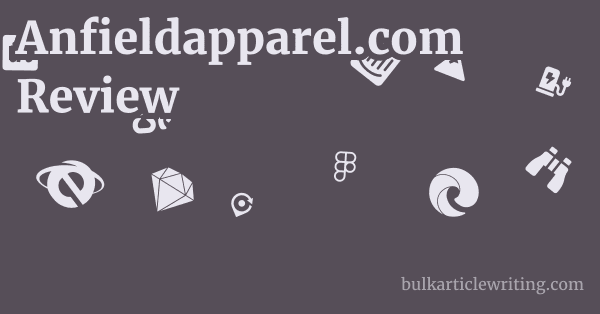
The world of merchandising, particularly in sports, operates at the intersection of fan passion and strict legal frameworks governing intellectual property (IP). For consumers and businesses alike, understanding the nuances of official versus unofficial merchandise, and the rights surrounding brands, logos, and player likenesses, is crucial.
Read more about anfieldapparel.com:
Anfieldapparel.com Review & First Look
Anfieldapparel.com Pros & Cons
Is Anfieldapparel.com Legit?
How to Check the Legitimacy of an Online Store
Anfieldapparel.com Alternatives
Is Anfieldapparel.com a Scam?
Understanding Website Transparency and Trust Indicators
This directly impacts the legitimacy and ethical standing of businesses like Anfieldapparel.com.
Official vs. Unofficial Merchandise
The primary distinction in sports merchandising lies between “official” and “unofficial” products.
- Official Merchandise: These products are produced under a direct license from the rights holder (e.g., Liverpool FC, Premier League, FIFA). The licensee pays a fee or royalty to the rights holder for the legal right to use their trademarks, logos, player names, and other intellectual property.
- Benefits: Guarantees authenticity, often higher quality control, directly supports the club/organization, and is generally free from legal disputes.
- Examples: Jerseys with official club badges, scarves with licensed logos, official club-branded mugs.
- Unofficial (Fan-Made) Merchandise: These products are created and sold without a formal license from the rights holder. They often draw inspiration from club culture, chants, player names, or iconic moments.
- Challenges: Risks infringing on trademarks, copyrights, or publicity rights. While some designs might be sufficiently transformative or generic to avoid direct infringement, others walk a fine line.
- Examples: T-shirts with fan slogans, art prints referencing club history, or designs inspired by player nicknames, like those seen on Anfieldapparel.com.
Trademarks, Copyrights, and Publicity Rights
These are the cornerstones of intellectual property protection relevant to merchandising.
|
0.0 out of 5 stars (based on 0 reviews)
There are no reviews yet. Be the first one to write one. |
Amazon.com:
Check Amazon for Understanding Intellectual Property Latest Discussions & Reviews: |
- Trademarks: Protect names, logos, slogans, and other identifiers used to distinguish goods or services. For example, “Liverpool FC,” the club’s crest, or specific slogans like “You’ll Never Walk Alone” (when used in a commercial context and trademarked by the club) are protected by trademark law.
- Infringement: Using a trademarked name or logo without permission, in a way that causes consumer confusion (e.g., making consumers believe it’s an official product), constitutes infringement.
- Copyrights: Protect original artistic and literary works. This can include specific designs, graphic artwork, photographs, or written content.
- Infringement: Copying a specific design, image, or text that is copyrighted without permission.
- Publicity Rights (Right of Publicity): Protect an individual’s right to control the commercial use of their name, image, likeness, or other aspects of their identity. This is particularly relevant for player merchandise.
- Infringement: Using a player’s name (e.g., “Mo Salah”), image, or nickname (e.g., “The Egyptian King”) for commercial purposes without their explicit permission or the permission of their authorized representatives (e.g., agents, club).
Implications for Businesses and Consumers
For businesses like Anfieldapparel.com, navigating these IP laws is a constant challenge.
- Risk of Legal Action: Companies selling unofficial merchandise risk legal action from the rights holders for trademark or copyright infringement, or violation of publicity rights. This could lead to injunctions, damages, and costly legal battles.
- Design Strategy: Many unofficial merchandisers try to create designs that are inspired by, rather than directly copying, protected IP. They might use oblique references, fan-generated slogans, or artwork that is distinct enough to avoid direct infringement.
- Consumer Awareness: As a consumer, it’s important to understand that unofficial merchandise, while often more unique or “authentic” to fan culture, does not contribute financially to the official club or players in the same way licensed products do.
- Ethical Consideration: While the products themselves (clothing, mugs) are permissible from an Islamic perspective, the underlying business practice of potentially infringing on intellectual property rights can be viewed ethically. In Islam, respecting contracts and rights (including intellectual property rights if they are recognized as such in a just legal system) is important. However, IP laws are complex and vary globally, and the line between inspiration and infringement is often debated. For the consumer, purchasing from a company that maintains a good reputation and delivers on its promises (like Anfieldapparel.com appears to do based on Trustpilot) is the primary concern.

Leave a Reply